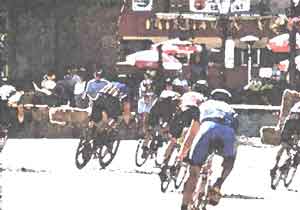|
Slam dunk digital lessons are designed to deliver learning with simplicity, efficiency and ease. They are meant to enhance existing unit plans by adding new information resources where they will do the most good. They are not a case of technology for technology's sake.
Originally designed to provide appealing lessons for those teachers who had long viewed the new technologies with skepticism, apprehension and reluctance, slam dunk lessons have proven effective with a full range of teachers and their students, as they provide well structured, brief learning experiences that require students to do challenging thinking. They are standards-based and are usually provocative, motivating and intriguing.
This article expands on earlier work by describing five types of slam dunk digital lessons. While teachers may ultimately invent dozens of other types, this article is meant to broaden the menu of opportunities while encouraging teachers to dream up even more lesson types.

1. The Original Type - Rich Site/Essential Question
The first slam dunk lesson examples were based around the strategy of finding a rich Web site on a content area such as weather - NOAA, for example - and then conceiving an essential question to challenge students to mine and interpret the rich information.
- When you compare hurricanes during the past century, which hurricane was the worst of them all? What traits make a hurricane especially damaging?
2. The Dramatic Image
The next type of digital lesson to emerge was a lesson tied to the interpretation or discussion of a single powerful image. This might be a photograph from the Library of Congress, a digital image collected locally or a photograph made while visiting historical sites.
3. The Database
As with most slam dunk lessons, the planner combines a "chunk" of information with a set of challenging questions requiring the student to interpret or make sense of the data. The chunk might be an image, a passage of text or a collection of data.
|
What do these numbers tell us?
| Year - # Homicides
1985 - 301
1986 - 347
1987 - 323
1988 - 366
1989 - 351
1990 - 447
1991 - 500
1992 - 387
1993 - 317
1994 - 295
1995 - 276
1996 - 217
1997 - 209
1998 - 252
1999 - 191
2000 - 231
|
What do you think is happening to homicide in this city?
Mark each of your observations with a code:
- F = Completely factual, beyond doubt or challenge.
- Inf = Reasonable inference
- ??? = Creative, imaginative hunch
What other information would you need to gather to build a strong case for your inference, moving it toward fact rather than supposition?
Source of data is the U.S. Bureau of Justice.
|
|
Many slam dunk lessons raise questions of copyright, as the image, the text or the numbers may be copyrighted and not available for publication. In such cases, the lesson planner can provide a link to the chunk of information where it resides, thereby avoiding unauthorized use of copyrighted material. Alternatively, the planner may e-mail the copyright owner and request permission.
Next is an example of a slam dunk lesson that refers students to a database on an organization's Web site, opening a new window for the data so the directions remain visible.

|
What Kind of Childhood?
|
| Introduction
Some parts of the United States are harder on children than others. We can learn about life conditions by exploring statistics. These same statistics and data can also help us to make important life decisions.
Information Challenge
- What are the five best states to be a child or a teen?
- What are the five hardest states to be a child or a teen?
- To which state would you move based on these numbers?
To help you decide, you and your partner will look through the state rankings and profiles at KIDS COUNT. KIDS COUNT is a project of the Annie E. Casey Foundation.
You will have 20 minutes to look at the following data in order to answer the questions above. Open a word processor to write your answers as you build them.
Data Available - State Rankings
http://www.aecf.org/cgi-bin/rs.cgi?action=newranking
|
4. The Provocative Article, Poem or Text Passage
The Web offers a rich assortment of articles touching on current events and issues. In addition to articles available from news sources listed at Yahoo (http://news.yahoo.com), Google (http://news.google.com/) and MSN.COM (http://msnbc.msn.com/), many schools subscribe to online periodical collections that offer much more than what is available on the so-called free Internet. Many of these articles can serve as the basis for a high impact, slam dunk digital lesson.
Warning! Many of these article links may disappear after 30 days because the source moves them to an archive. You may want to use articles from periodical collections for which your district has subscriptions, as these articles will not disappear.
What Should be Done?
|
 |
The world of sports is being disrupted by a huge focus on the use of drugs to enhance performance.
Read the Associated Press article below about U.S. sprinter Jerome Young and write answers to the following questions . . .
1. What were the charges against Young?
2. Does the decision of the Court of Arbitration for Sport seem fair to you? Provide 3-4 reasons to support your stand.
3. How clearly does this article state the evidence against Young? What else would you want to know to make a final decision?
4. Should the other members of Young's relay team lose their gold medals? Give 2-3 reasons to support your stand.
 Click here to read the AP article, "Court: Young Should Forfeit Olympic Gold" - Wednesday, June 30. By ROB GLOSTER, AP Sports Writer Click here to read the AP article, "Court: Young Should Forfeit Olympic Gold" - Wednesday, June 30. By ROB GLOSTER, AP Sports Writer
|
5. The Persuasive Image
Slam dunk lessons often require analysis and interpretation, but they can just as easily focus on synthesis, asking students to harvest a great image and combine it with powerful text to express a message that is full of impact and import.
 |
A Picture Worth 1,000 Words
|
Imagine you have been chosen to develop a one page ad for one of the following campaigns. Few words. One powerful image.
Campaign 1 - Ad for arthritis medicine
Campaign 2 - Ad for blood pressure medicine
Campaign 3 - Ad for anti-depressant medicine
Campaign 4 - Ad for cough medicine
You are allowed only one picture and only 40 words to create your ad. Note that each campaign may address a different audience with different tastes, wishes, dreams and fears.
Go to Corbis.Com to identify the perfect image. Copy or save it.
Paste the image into your word processing program. (Note that all these images are for sale, are watermarked and may not be kept beyond the duration of this lesson.) Add your 40 words. Then write a few sentences explaining why you selected the picture you included.
How much would it cost to use this image in a real life ad campaign?
|
The Construction Process
Templates are available as part of Module Maker 2 at http://questioning.org/module2/quick10.html that can be used to structure the learning experiences. As teachers venture out into different types of slam dunk lessons, they will find themselves modifying these templates and creating their own structures to match the activities they have designed.
When creating these lessons, it is important to keep in mind basic design criteria:
- Directions should be brief and clear.
- The activities should be well structured.
- Searching and wandering is minimal.
- The learning should require analysis, synthesis or evaluation.
- Lessons are standards-based.
Going Public
In some districts it takes a long time to publish lesson pages on school web sites. For this reason, it makes some sense to create early versions of the lesson as word processing files that can be used immediately by students. Most word processing programs now permit the inclusion of links to Web pages, so fully functioning lessons can be built without knowledge of HTML or web design. At a later date after the lessons have been tested and refined, they may be posted.
|
 From Now On
From Now On






